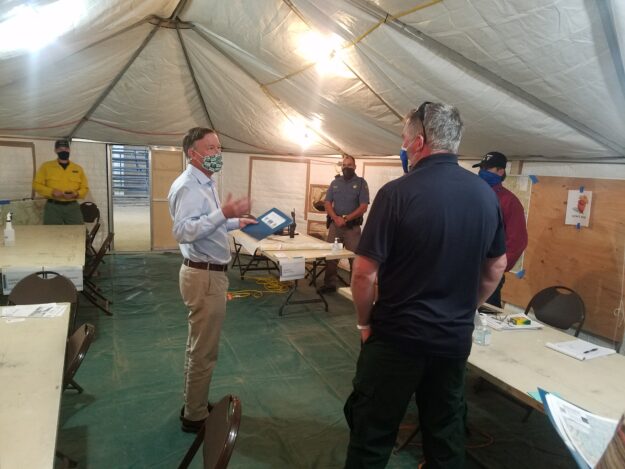Widgetized Section
Go to Admin » Appearance » Widgets » and move Gabfire Widget: Social into that MastheadOverlay zone
Hickenlooper offers climate plan as wildfires rage across western United States

As massive wildfires ravage California, Washington and Oregon, much cooler, wetter weather over the last week has eased the danger somewhat in Colorado, which just endured one of the hottest, smokiest Augusts on record.
Just to the west of Eagle County, the White River National Forest saw its largest fire ever – the 32,000-plus-acre Grizzly Creek Fire that shut down Interstate 70 through Glenwood Canyon for a record two weeks. Further west, the Pine Gulch Fire in Mesa County was the largest in state history at nearly 140,000. Both are now more than 90% contained thanks to recent weather.
Interviewed last week at the Grizzly Creek Fire incident command center at the Eagle County Fairgrounds, former Colorado Gov. John Hickenlooper, who’s running for U.S. Senate, weighed in on the size of the recent fires and the fact that, fueled by climate change, 19 of the 20 largest fires in state history have happened since 2000.
“These are big fires,” said Hickenlooper, who this week started running ads touting his plans to combat climate change. “Out [in Mesa County] we have the biggest fire in the history of Colorado [Pine Gulch], and then Grizzly Creek is 32,000 acres, so it’s a big fire too. So, two giant fires in the height of the tourist season when we’re in the middle of COVID-19 already.”
Hickenlooper, a Democrat who is challenging incumbent Republican Sen. Cory Gardner in the Nov. 3 election, spoke to the convergence of the climate and COVID crises.
“What I’m amazed by is the character and the resilience of the firefighters and these incident commanders who are out there in COVID; they’re having to rethink how they do everything to make sure that no one gets infected by the virus,” Hickenlooper said. “So it’s not just fighting the fire, it’s fighting the fire and the virus at the same time.”
The beneficiary of new ads from environmental groups backing Hickenlooper, the former governor and mayor of Denver said that as drought intensifies and temperatures steadily increase, Colorado is at risk of even larger fires in the near future.
“The last time I was at NREL, the National Renewable Energy Lab [in Golden], 11 of the 12 models they had predicting climate change had an increasing rain shadow for most of Colorado. In other words, we would get less precipitation,” Hickenlooper said. “The part that’s almost more concerning is the increasing rise in temperature, which means we’re getting less of a snowpack and it is melting and evaporating or getting sucked into the dry ground so we’re not getting as much runoff into our rivers to help our ranchers and our farmers on the Eastern Plains and in the high country out here.”
Hickenlooper then brought it back to the science around stopping a pandemic like COVID-19.
“Every scientist, or pretty much every scientist I’ve talked to, thinks [climate change is] a very serious concern,” Hickenlooper said. “The issue is it’s a little bit like COVID, right? We can address it now without it costing that much money. We can move towards cleaner energy and have cleaner air. There’s lots of innovation and new jobs — not just new jobs, but new industries — that are going to come out of a transition into cleaner energy. But we’ve got to go now and not have to do it in a rush. When you look at things like rising sea levels in South Florida, how much is that going to cost if we don’t get out ahead of it and it keeps happening for another 20, 30, 40 years? I mean, the cost becomes astronomical.”
The office of Colorado Gov. Jared Polis put out the following wildfire update on Friday:
Wildfires continue to rage across the West, taking a tragic toll on lives and property. These mega-fires are fueled by more frequent, severe heat waves and intense drought — a direct result of a changing climate. Colorado is no stranger to extreme blazes and fluctuating weather patterns. However, the severity of these factors has culminated into one of the most devastating wildfire seasons on record. Please see below for containment updates on Colorado’s five largest wildfires:
- Grizzly Creek Fire: 32,431 acres, 91% contained
- Williams Fork Fire: 12,157 acres, 10% contained
- Pine Gulch Fire: 139,007 acres, 91% contained
- Cameron Peak Fire: 102,596 acres, 4% contained
- East Fork Fire: 1,682 acres, 85% contained


